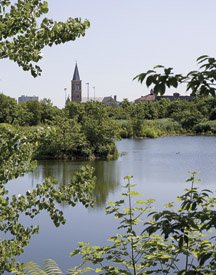Few would use the words “lush green oasis” in the same breath with Jersey City Heights. Yet this hardscrabble neighborhood is indeed home to one of the city’s most beautiful outdoor gifts: the Jersey City Reservoir.
A 14-acre site situated between Summit, Central, and Jefferson avenues, the reservoir sits opposite from the popular Pershing Field. It is open each week for fishing and has hosted other events.
Hundreds of residents probably pass the 20-foot brick walls that guard the reservoir site each day but know nothing about what’s on the other side. Most of the city’s newer residents likely don’t know it exists, and even some natives probably forget that it’s there.
The alliance would like for the site to be preserved as an “unmanicured” natural environment.
____________
Efforts to preserve the reservoir will reach a critical juncture later this fall when a team of engineers will conclude a two-year site analysis that members of the alliance and city officials hope will provide specific ways it can be re-made into a passive, recreational park.
There’s also the expectation that the site analysis results will give the city a clearer understanding of which federal and state funding sources might be available for the reservoir’s preservation and how much money will be needed.
Members of the public will have opportunities to weigh in on the results of this analysis before the city makes any final decisions on conceptual plans for the site, Latham said.
Rich history
The reservoir provided drinking water to city residents until it was decommissioned around 1990.
Built in the late 1870s, the reservoir – officially known for years as Reservoir No. 3 – was planned as part of an integrated series of water supplies that would provide potable water for city residents. For at least 110 years the reservoir system did just that until it was shut down and the city started getting its drinking water from the Boonton Reservoir in Morris County.
After its closure, Reservoir No. 3 was abandoned for years and it soon looked like little more than a rock quarry littered with trash and marked with graffiti.
As land in the city increased in value through the 1990s, developers became interested in purchasing the city-owned property for condo construction, and the city considered its own plans to convert the reservoir into municipal recreational ball fields or a public school campus.
A group of concerned citizens and activists, who ultimately became the Jersey City Reservoir Preservation Alliance, got to together in 2002 to block these plans and began advocating for a different vision for the site.
The alliance would like for the site to be preserved as an “unmanicured” natural environment that maintains the reservoir’s current meadow feel and establishes a sanctuary for the animal and plant life currently living there. However, alliance members would also like to see enhanced recreational features.
The alliance’s vision for the reservoir eventually received the blessing of the Jersey City Council and Mayor Jerramiah Healy.
In 2009 the city obtained a grant from the Hudson County Open Space Trust Fund to hire engineers and architects to spearhead a site analysis of the reservoir.
That analysis – which is being conducted by John Milner Associates, Michael Van Valkenburgh Associates, Robert Silman Associates, and Princeton Engineering – will be completed this fall.
A visit to the reservoir
But residents needn’t wait until preservation plans are implemented. Volunteers from the alliance already offer a small array of activities for visitors who are interested in exploring what’s been called the city’s “hidden jewel.”
Each Saturday visitors to the reservoir can fish in the 6-acre body of water – which could be described as a small lake – and occasionally there are opportunities for people to boat there as well. Latham also leads guests on guided walking tours through the reservoir.
“People are free to walk and discover the site on their own,” said Latham, noting that guests aren’t required to participate in the guided activities. “We have a lot of people who come who have taken an interest in the plant life that’s growing there. So, they come to explore that. It’s great to see people picnicking out there.”
For more information about activities and events at the Jersey City Reservoir, visit www.jcreservoir.org or call (201) 656-5235.
E-mail E. Assata Wright at awright@hudsonreporter.com.
